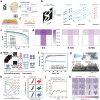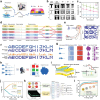Bio-Inspired Neuromorphic Sensory Systems from Intelligent Perception to Nervetronics
- PMID: 39527666
- PMCID: PMC11714237
- DOI: 10.1002/advs.202409568
Bio-Inspired Neuromorphic Sensory Systems from Intelligent Perception to Nervetronics
Abstract
Inspired by the extensive signal processing capabilities of the human nervous system, neuromorphic artificial sensory systems have emerged as a pivotal technology in advancing brain-like computing for applications in humanoid robotics, prosthetics, and wearable technologies. These systems mimic the functionalities of the central and peripheral nervous systems through the integration of sensory synaptic devices and neural network algorithms, enabling external stimuli to be converted into actionable electrical signals. This review delves into the intricate relationship between synaptic device technologies and neural network processing algorithms, highlighting their mutual influence on artificial intelligence capabilities. This study explores the latest advancements in artificial synaptic properties triggered by various stimuli, including optical, auditory, mechanical, and chemical inputs, and their subsequent processing through artificial neural networks for applications in image recognition and multimodal pattern recognition. The discussion extends to the emulation of biological perception via artificial synapses and concludes with future perspectives and challenges in neuromorphic system development, emphasizing the need for a deeper understanding of neural network processing to innovate and refine these complex systems.
Keywords: artificial synapse; bio‐inspired; machine learning; neuromorphic sensory system.
© 2024 The Author(s). Advanced Science published by Wiley‐VCH GmbH.
Conflict of interest statement
The authors declare no conflict of interest.
Figures








Similar articles
-
Organic Synapses for Neuromorphic Electronics: From Brain-Inspired Computing to Sensorimotor Nervetronics.Acc Chem Res. 2019 Apr 16;52(4):964-974. doi: 10.1021/acs.accounts.8b00553. Epub 2019 Mar 21. Acc Chem Res. 2019. PMID: 30896916 Review.
-
Biomimetic Neuromorphic Sensory System via Electrolyte Gated Transistors.Sensors (Basel). 2024 Jul 29;24(15):4915. doi: 10.3390/s24154915. Sensors (Basel). 2024. PMID: 39123962 Free PMC article. Review.
-
Flexible Neuromorphic Electronics for Computing, Soft Robotics, and Neuroprosthetics.Adv Mater. 2020 Apr;32(15):e1903558. doi: 10.1002/adma.201903558. Epub 2019 Sep 26. Adv Mater. 2020. PMID: 31559670 Review.
-
Inspiration from Visual Ecology for Advancing Multifunctional Robotic Vision Systems: Bio-inspired Electronic Eyes and Neuromorphic Image Sensors.Adv Mater. 2024 Nov;36(48):e2412252. doi: 10.1002/adma.202412252. Epub 2024 Oct 14. Adv Mater. 2024. PMID: 39402806 Review.
-
Bio-inspired multimodal learning with organic neuromorphic electronics for behavioral conditioning in robotics.Nat Commun. 2024 Jun 4;15(1):4765. doi: 10.1038/s41467-024-48881-2. Nat Commun. 2024. PMID: 38834541 Free PMC article.
Cited by
-
Memristor-Based Spiking Neuromorphic Systems Toward Brain-Inspired Perception and Computing.Nanomaterials (Basel). 2025 Jul 21;15(14):1130. doi: 10.3390/nano15141130. Nanomaterials (Basel). 2025. PMID: 40711249 Free PMC article. Review.
References
-
- Oosting P. H., Rep. Prog. Phys. 1979, 42, 1479.
-
- Wang J., Wang C., Cai P., Luo Y., Cui Z., Loh X. J., Chen X., ACS Nano 2021, 15, 18671. - PubMed
-
- Wang S. Y., Chen X. Z., Huang X. H., Zhang D. W., Zhou P., Adv. Intell. Syst. 2020, 2, 2000124.
-
- Lee Y., Lee T. W., Acc. Chem. Res. 2019, 52, 964. - PubMed
-
- Park H. L., Lee Y., Kim N., Seo D. G., Go G. T., Lee T. W., Adv. Mater. 2020, 32, 1903558.
Publication types
MeSH terms
Grants and funding
LinkOut - more resources
Full Text Sources
